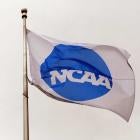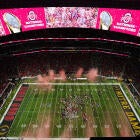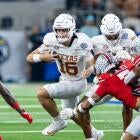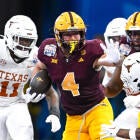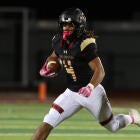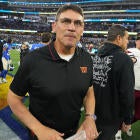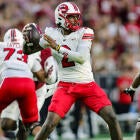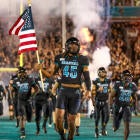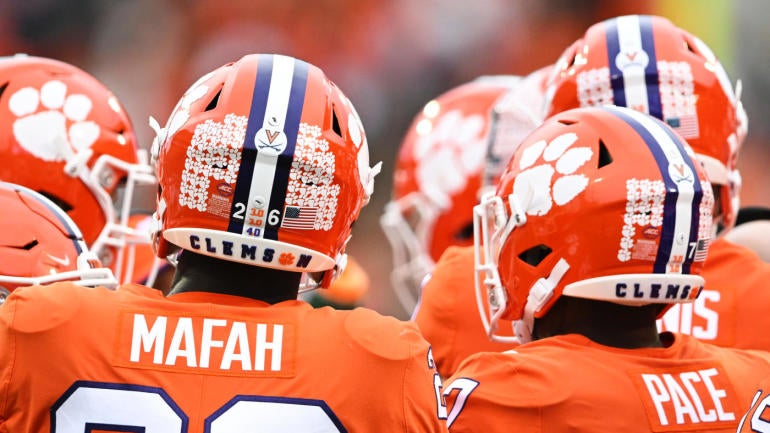
This whole sign-stealing mess could be solved in, well, a snap.
Part of the answer lies in a small two-room office in Rochester, Minn. It is there that GoRout, a firm well-known in football circles, makes its headquarters. The company has staff in 23 states. Its products are in all 50 states and three countries. GoRout now supplies 45 Division I programs with communication devices that, for the first time in FBS, will be more than a talking point.
They'll be the foundation for the future. That is, if you really want to get rid of the Connor Stalions of the world.
"That was our pitch to the [NCAA Football Rules] committee," said Mike Rolih, GoRout founder and CEO. "That was our pitch to every conference. What you guys are talking about doing is not going to solve your ultimate problem."
That problem is the gray area that Stalions -- Michigan's infamous rogue sign-stealer -- blew past in the case the NCAA said recently reflected "a pattern of non-compliance" by Michigan. Coincidentally, the NCAA in the offseason adopted coach-to-player helmet communications (referred to hereon as "helmet comms") that, in theory, should cut down on that sign-stealing. The NFL has been using the technology since 1994.
Coaches for all 134 FBS teams will now be able to call in plays into the helmet of one player on each side of the ball. Like the NFL, the technology will switch off with 15 seconds left on the play clock.
The average fan probably won't even notice. But as the 2024 season opens, it may prove to be the biggest rule change in recent years, in part because it can't cure sign-stealing. At least not altogether. That's where Rolih and GoRout come in. The company is arguably the industry leader in what are called "wearables" -- electronic devices worn by baseball, softball, and football players to signal in plays and pitches.
Think of an enhanced Apple Watch. In football, a wearable screen lights up on a forearm sleeve or belt buckle device communicating the play. No crowd noise interferes. If worn by every player, no communicating to the rest of the team. Such a process would allow everyone on that side of the ball to know the play immediately.
As the technology progresses, you could conceivably punch in "audibles" as the defense adjusts.
End of sideline signs. End of sign-stealing.
Again, in theory.
"We spent a year talking to them about things," Rolih said of the NCAA. "[It was] really trying to educate that there is a different mousetrap, a different way to approach it."
If the rule change doesn't completely address a larger concern, it certainly raises a key question: Is an actor like Connor Stalions an outlier or a symptom of greater concern?
"It didn't surprise me," Rolih said of last fall's revelation. "It's been going on for years. I think anytime you go above and beyond what's actually going on in the game, the scalability is really irrelevant. In my opinion, it didn't surprise me, but at the same time, you almost kind of hope it doesn't get to that."
In essence, helmet comms don't go far enough, according to Rolih and critics within the game. With the helmet device turning off with 15 seconds left, not only can teams still signal in plays, they will have to signal in to compensate for whatever the opponent does.
Unless college teams huddle, like NFL teams do, there will always be a hole in the system for signals to be stolen. That's one basic difference in the way each version of the game is played. Scores of college teams go no-huddle, up-tempo to tire out a defense.
NFL teams essentially don't, preferring to huddle on most offensive plays.
Texas Tech coach Joey McGuire is one of those critics. Last year's bowl season teams were given the option of using helmet comms and tablets (also used by the NFL and approved by the NCAA). In its Independence Bowl game against Cal, the Red Raiders used eight wired helmets, two on offense and six on defense: The starting quarterback and his backup on offense, a safety, and two linebackers and their backups on defense.
That's twice the number of players on the field that will be allowed to wear the helmet comms this season.
Not only did it improve communications, McGuire said his defense didn't have to receive sideline signals once.
"You could have fixed it and they chose to take the easy way out and do the NFL model," McGuire said of the rules committee. "Guess what? We don't huddle [on offense]. How is that fixing anything?
"I've got a whole frustration level on it. I wish they would have said, 'If we're going to use the NFL [method], let's use it in [more than] the bowl games, instead of letting us experience the perfect way to do it and taking it away.'"
It's not like the rules committee isn't thinking ahead. The man on the street may think helmet comms were instituted because of the sign-stealing scandal. Not true. The change had been discussed for years, but expense seemed to be an issue.
The Big Ten proposed using helmet comms last season. That was too soon for the rules committee. Instead, participating schools were allowed to use them 3 ½ months later, beginning in those bowls. The timing of the rule change collided with Michigan's scandal.
"I know there is a familiar refrain out there that the issues at Michigan were the driver of all this," said Steve Shaw, secretary-editor of the rules committee. "It had started before anything we knew as breaking news at Michigan."
This season, two Division III conferences have the option of using those wearables as an experiment. GoRout is outfitting the Liberty League. Competitor Armilla Technology is working with the Old Dominion Athletic Conference.
"The wearables, to me, are the natural progression," said Old Dominion commissioner Brad Bankston. "We have a coach in the league that plays a no-huddle environment. He advocated for all 11 [players wearing them]."
Perhaps someday. For now, this is technology in progress. At least one member of that 11-member NCAA rules committee advocated for all 11 players wearing helmet comms, sources told CBS Sports. Anything less seems to leave an opening for sign-stealing, which is not rocket science for trained eyes.
"I went to a Penn State game three or four years ago," Shenandoah University coach Scott Yoder told CBS Sports. Shenandoah is part of that Old Dominion Athletic Conference using wearables.
"I tried to pick signals. You can figure it out. That's just me with no preparation. You can figure out who is signaling to what group and what a couple of signals mean."
All of college football has been taught a lesson. At that Division III level, Pedro Arruza's games are on live streams so fans could watch online.
"I always tell our SID, 'Hey, pull it down right away so people can't steal our signals,'" said Arruza, head coach at Randolph-Macon College. "We definitely thought that people were onto us with that."
There remains a fine line between cheating and gamesmanship. What Yoder did that day at Penn State is acceptable, as long as he was doing it on game day from the opposing sideline. It's the extent that Stalions reportedly went to that made it national headlines, traveling to scout opponents. That included, at one point, according to the NCAA, disguising himself as a Central Michigan staffer on the Chippewas' sideline.
No recent rule change has been more attached to recent (nefarious) events. The Stalions scandal hangs over Michigan, and really the sportm like a drunk uncle. In both cases, people won't stop talking about him, and he definitely won't go away. Stalions is the subject of a Netflix documentary available to watch Aug. 27.
The fallout from that scandal has made an umbrella necessary.
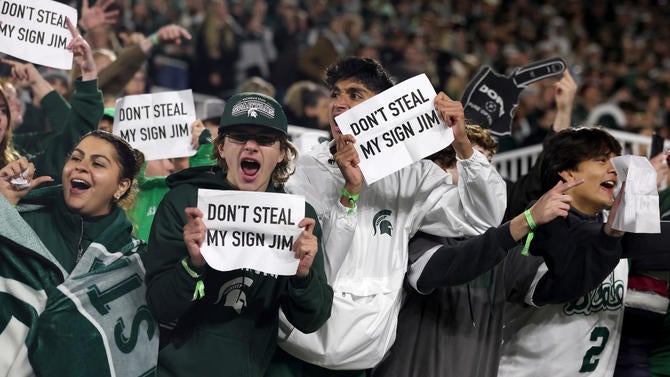
Alex Shada is still receiving reactions to his reply on the topic to CBS Sports earlier this year. Shada is the head of GSC, the company that has been the exclusive provider of helmet devices to the NFL since 2012. GSC will also outfit all 68 Power Four schools this season.
"I did not add Jim Harbaugh to our family Christmas list," he said, "but we probably should."
That said, would Stalions have happened had helmet comms been in place? No? Probably? Maybe? As mentioned, the rule change doesn't eliminate signs from the sideline. And as long as there are signs, there are going to be folks stealing them.
"Sign stealing is not, per se, illegal," Shaw reminded. "If you're smart enough to watch a coach and see what they're doing. What's illegal is when you video them.
"That's been part of the game since the beginning of time. But clearly you're trying to gain advantage if you videotape them, try to break it down, and then figure it out."
The rules committee voted March 1 to add helmet comms. The change was officially approved on April 19 by the Playing Rules Oversight Panel.
Serendipity has caught up with the change. Gallaudet University is joining the Old Dominion Athletic Conference this year as an associate member in football. Gallaudet, the global leader in deaf education, happens to have invented the huddle in 1894. Huddling continues to largely insulate the NFL from sign stealing.
"I do think with player-to-coach communications, you're going to see more huddling," Ohio State coach Ryan Day said. "More plays, possibly. I feel like huddling is kind of a lost art. I think people find themselves getting back to that, not showing the formation."
"You have to still signal with helmet comms," Arkansas coach Sam Pittman said. "The only way you can do that is just everybody on the field have one. It's just going to be a liability right now."
"My guess is that in two years we're not even arguing about this," Yoder said. "Maybe the capacity changes a little bit. You fight technology and you really realize if we would have done this a couple of years ago, we would have known what the good and what the bad is."
Since the 2024 rulebook was printed earlier this year, the rules have been amended. The stakeholders had to think deeply enough to consider kickoffs. Helmets won't be allowed to be switched on during kickoffs, field goals, etc. That addendum had to be added to the online-only version of the rulebook.
Other nuggets:
- Coaches will have to adjust if they run Wildcat. That particular player behind the center replacing the quarterback cannot have a wired helmet (marked with a green dot).
- Teams that get flagged for having more than one "hot" helmet will be penalized five yards.
Also, if hackers can take down giant corporations with ransomware, what's to keep some enterprising anarchist from tuning in to a helmet frequency? It's one thing wiring 32 NFL stadiums. It's another installing new technology at 134 FBS schools.
Is Shaw nervous?
"Nervous is not the right term," he said. "What I'm anxious to see is all the work the conferences have done to make sure it pays off."
![[object Object] Logo](https://sportshub.cbsistatic.com/i/2020/04/22/e9ceb731-8b3f-4c60-98fe-090ab66a2997/screen-shot-2020-04-22-at-11-04-56-am.png)







